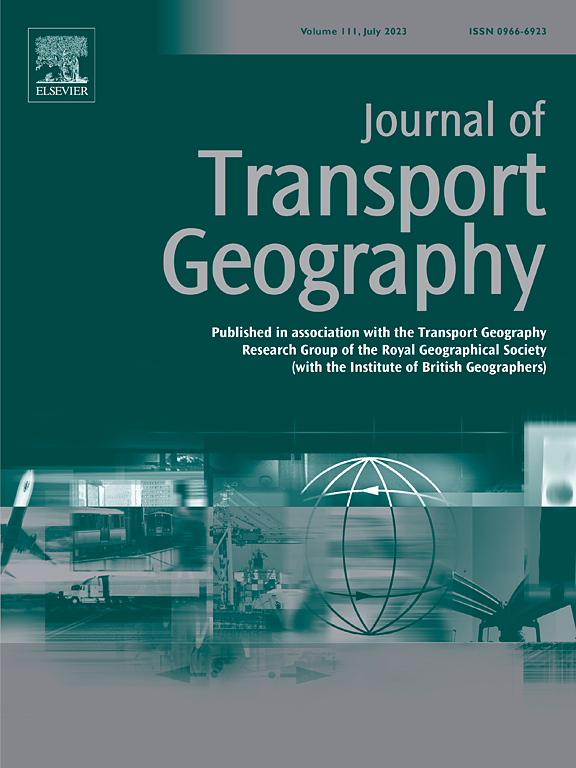COVID-era built environment and travel: Insights from location-based services data
IF 5.7
2区 工程技术
Q1 ECONOMICS
引用次数: 0
Abstract
This study revisits the linkage between land use interventions and travel behavior in the COVID era using increasingly available cell phone-based individual mobility data. Reducing the carbon emissions associated with personal vehicle travel is crucial to achieving climate targets; policies such as California's Senate Bill 375 require that land use planning achieve climate targets at the regional level. The implementation relies heavily on local placemaking efforts such as higher density infill development and walkable streets which have long been considered potential reducers of automobile travel. However, the rise of telework, decline of transit, and increase in pedestrian deaths following the pandemic have cast doubts on the efficacy and cost-effectiveness of strategies seeking to foster low-Vehicle Miles Traveled (VMT) location patterns. This study uses StreetLight Insight data on vehicle trip origination at the census tract-level before and after the emergence of COVID-19 (2019 and 2021) to assess the contribution of several built environment measures to VMT and to the share of short trips in the 6-county Southern California region. Despite concerns over COVID-induced changes, we find that several built environment measures remain solidly associated with travel efficiency in multivariate models investigating VMT levels, VMT rebound, and the share of trips that are shorter than two miles. While the prevalence of neighborhood-scale destinations is an activity generator, it also fosters shorter trips, and a region-level measure of job accessibility provides some evidence that more populated areas nearer the region's core did indeed struggle to return to pre-COVID activity levels. After the first year of the pandemic, VMT rebound was most pronounced in tracts with a high share of residents under the age of 18, suggesting that while many adults did not return to prior activity patters (e.g. due to telecommuting), children mostly did. Findings suggest that local policies and placemaking efforts, including 15-minute communities, may still be promising trip reducers, while near real-time data provides a mechanism for far faster performance evaluation.
新冠时代的建筑环境和旅行:基于位置服务数据的见解
本研究利用越来越多的基于手机的个人出行数据,重新审视了COVID时代土地利用干预措施与出行行为之间的联系。减少与个人车辆出行相关的碳排放对于实现气候目标至关重要;诸如加州参议院375号法案等政策要求土地利用规划达到区域层面的气候目标。实施在很大程度上依赖于当地的场所营造努力,如高密度填充开发和步行街道,这些一直被认为是潜在的汽车旅行减少。然而,远程办公的兴起、交通工具的减少以及大流行后行人死亡人数的增加,使人们对寻求促进低车辆行驶里程(VMT)定位模式的战略的有效性和成本效益产生了怀疑。本研究使用StreetLight Insight在2019年和2021年(2019年和2021年)出现之前和之后的人口普查区层面的车辆出行数据,以评估几种建筑环境措施对南加州6个县的车辆行驶里程和短途出行份额的贡献。尽管人们对covid - 19引起的变化感到担忧,但我们发现,在调查VMT水平、VMT反弹和短于2英里的旅行比例的多变量模型中,一些建筑环境措施仍然与旅行效率密切相关。虽然社区规模目的地的流行是一个活动的来源,但它也促进了短途旅行,一项区域层面的工作可达性指标提供了一些证据,表明靠近该地区核心的人口较多的地区确实难以恢复到疫情前的活动水平。在大流行的第一年之后,在18岁以下居民比例很高的地区,VMT反弹最为明显,这表明,虽然许多成年人没有恢复到以前的活动模式(例如,由于远程办公),但大多数儿童都恢复了。研究结果表明,包括15分钟社区在内的地方政策和场所建设努力可能仍然有希望减少出行,而近实时数据提供了一种机制,可以更快地进行绩效评估。
本文章由计算机程序翻译,如有差异,请以英文原文为准。
求助全文
约1分钟内获得全文
求助全文
来源期刊

Journal of Transport Geography
Multiple-
CiteScore
11.50
自引率
11.50%
发文量
197
期刊介绍:
A major resurgence has occurred in transport geography in the wake of political and policy changes, huge transport infrastructure projects and responses to urban traffic congestion. The Journal of Transport Geography provides a central focus for developments in this rapidly expanding sub-discipline.
 求助内容:
求助内容: 应助结果提醒方式:
应助结果提醒方式:


